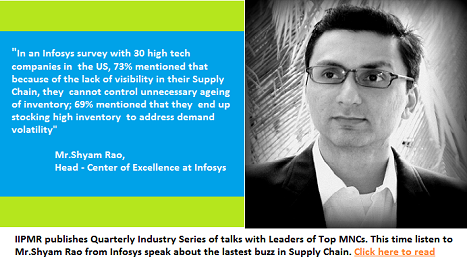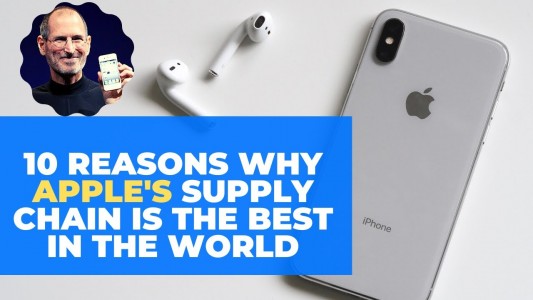Please brief us about your profile at Infosys?
Head of the Center of Excellence for Sales and Fulfillment Practice at Infosys and lead business development through thought leadership in domain and value added services both within the practice and to external clients.
What are the significant milestones achieved under your leadership at Infosys?
Anchored the development of “Sales and Fulfillment” as a mature practice by building and implementing service offerings and transformation initiatives in the Supply Chain covering the “Procure to Pay” and “Order to Cash” value chains. Initiate best practices, benchmarking, domain training and continuous improvements within existing engagements. Developed industry specific supply chain strategies and delivered business value through benchmarking and optimization of operations of Fortune 500 clients
What are the key challenges that companies face today in their supply chain?
The challenges in the supply chain are an outcome of its historical development over the past few decades. Due to the rapid globalization of supply chain operations, to the continuous evolution of SCM technologies to support sophisticated global operations, we see two main Supply Chain Challenges of Visibility and Cost take center stage:
Visibility: Supply chains spread globally with myriad technologies that do not always work in tandem leading to risk of supply chain disruptions due to local factors or system breakdowns. The recent natural disasters in Japan and South East Asia showed us how fragile a globally dispersed supply chain can be. The disruption of supplies of semiconductors from Taiwan or China for instance can result in major breakdown in supplies electronic goods to the West. Similarly the adoption of different systems for SCM in different geos as the markets expanded in the east have led to a sub optimal value chains due to lack of technological integration of the value chain. A lack of global visibility due to the disbursed nature of supply chain operations and technology mismatch leads to low efficiencies of the supply chain. In an Infosys survey with 30 high tech companies in the US, 73% mentioned that because of lack of visibility they cannot control unnecessary ageing of inventory; 69% mentioned that they end up stocking high inventory to address demand volatility
Cost: The ongoing recession has placed cost pressures on further development of supply chain investments. With low appetite for costly capital investments firms have to try and optimize their supply chain investments with little or no budgets
Both these have led to companies not being able to improve supply chain efficiencies which ultimately effect both their topline and bottomline performance. For instance, it is estimated that 30.60% of the working capital requirements of the Top Fortune 1000 amounting to almost $740 billion is locked up in unnecessary assets.
There seems to be lot of buzz that cloud computing may replace traditional ERP tools used in supply chain? Do you see any benefits of cloud computing in supply chain?
Cloud computing addresses both of the above supply chain challenges of Visibility and Cost. A solution which can integrate various technologies and geographical supply chain operations into a seamless value chain can provide the visibility to optimize the supply chain in real time as well control and predictively manage risks of disruption. This coupled with the promise of cloud computing’s pricing model of pay-per-use with almost no capital investment will certainly be the next generation Supply Chain strategy which will replace our existing set ups
Do you see any significant changes happening in the near future in supply chain management?
The development of supply chains has been fast in the past few decades leading to very sophisticated but at the same time complicated and opaque systems. This is bound to change with the new mantra being “SIMPLIFY”. We will see three changes happening over this decade:
i. A move to cloud based platforms working on a PaaS model to integrate the supply chain and operate on an Opex model rather than an investment heavy Capex model
ii. Consolidation of the supply chain either through consolidation in technology or via optimization of the geographical reach of the supply chain
iii. Outcome based pricing will see renewed interest keeping in mind that both the nucleus company and its vendors have now reached a certain level of cost reductions and further improvements will need the involvement of all partners of the supply chain. This cooperation will be driven by outcome based pricing where the risk and rewards are shared by all the partners of the supply chain
Today it’s all about saving costs in procurement. Companies are aggressive in achieving cost savings. Due to this supplier’s profitability has dropped. Do you think this sets a bad precedent for new suppliers to enter the market?
The auto industry is well known for this phenomenon of contract mandated year on year reduction in prices. Even here, I see a movement to measuring the cost of the entire supply chain rather than individual supplier prices/costs. By using metrics such as overall supply chain costs together with outcome based pricing we should see better supply chain strategies and further cost reductions possible over the coming decade
Strategic Sourcing plays a key role in helping companies achieve costs savings. At the same time companies are staggering for want of new strategies. This is because they are unable to find new strategies every year and run out of ideas. So is savings possible every year?
Yes, as I mentioned earlier, due the historical development of supply chain strategy we are now saddled with a legacy of inefficient technologies, disbursed operations which are not integrated and some extremely inefficient operations. The bright side is that there is huge scope for improvement and savings waiting to be realized. For instance for every $1 billion of sales, a decrease in days in inventory (DII) by 5 days can decrease inventory costs by $10 million and reduce cost of capital by $1 million. Similarly an increase in fill rates by 1.5% can generate $15 million in additional revenue. These are big numbers and strategic sourcing, inventory management and fulfillment will be able to achieve these numbers.
With global demand rising for supply chain professionals and a shortage of trained manpower, how do you think this situation can be rectified?
Two major problems here – one is the lack of awareness of the opportunities in supply chain management and the other a lack of a systemic training program catering to supply chain professionals. The first is surprising considering the high demand and current shortage of manpower. However we still find that most graduates are not inclined or even knowledgeable about a career in the SCM. We need to popularize the opportunities available and scope of the field at university level itself and the industry must project and connect via campuses and industry forums. The second is the lack of training and exposure to SCM for the limited number of professionals who would like to make a career in SCM. It is mostly a learn on the job kind of scenario. This must change. Some measures we need to introduce are more courses at university level and vocational institutes for freshers and certification programs for professionals already in the field









